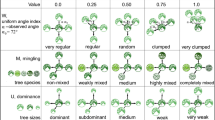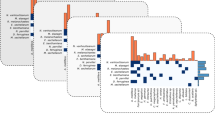Summary
A sampling method, compatible with the theory elaborated in the previous paper, was used to investigate the mixed-forest community of a woodlot in Southern Ontario. The results provide an illustration of the graph theoretical methods developed for the elucidation of a community's phytosociological structure. Certain conjectures about the community are tested and it is found that Goodall's hypothesis concerning the nature of a plant community is supported. The tests also show that the vegetation of the study area forms a single natural grouping despite the disparity of the position ofAcer saccharum and the polarity evident among the other tree species.
Similar content being viewed by others
References
Curtis, J. T. 1969. The Vegetation of Wisconsin. University of Wisconsin Press, Madison. 657 pp.
Dale, M. 1977. Graph theoretical analysis of the phytosociological structure of plant communities: the theoretical basis. Vegetatio 34: 137–154.
Gleason, H. A. 1926. The individualistic concept of the plant association. Bull. Torray Bot. Club 53: 7–26.
Gleason, H. A. 1952. The New Britton and Brown Illustrated Flora of the North-eastern United States and Adjacent Canada. Lancaster, Penna.
Goodall, D. W. 1966. The nature of the mixed community. Proc. Ecol. Soc. Australia 1: 84–96.
Hett, J. M. & O. Loucks. 1971. Sugar maple (Acer saccharum Marsh.) seedling mortality. J. Ecol. 59: 507–520.
Sukachev, V. 1925. Über die Methoden der Phytosoziologie. Englers. Bot. Jb. Beih. 135.
Yarranton, G. A. 1973. A graph theoretical test of phytosociological homogeneity. Vegetatio 28: 283–298.
Author information
Authors and Affiliations
Additional information
Nomenclature follows Gleason (1952).
From a thesis submitted to the University of Toronto in partial fulfilment of the requirements for the degree of Master of Science.
I wish to thank Dr. G. A. Yarranton for his ideas and helpful supervision, and my father for his advice and encouragement. Thanks ag also due to Miss J. E. Ellard and Mr. S. Roy who helped prepare the figures. This research has been supported by a National Research Council of Canada and by NRCC grant A-2910.
Rights and permissions
About this article
Cite this article
Dale, M. Graph theoretical analysis of the phytosociological structure of plant communities: An application to mixed forest. Plant Ecol 35, 35–46 (1977). https://doi.org/10.1007/BF02097133
Accepted:
Issue Date:
DOI: https://doi.org/10.1007/BF02097133




